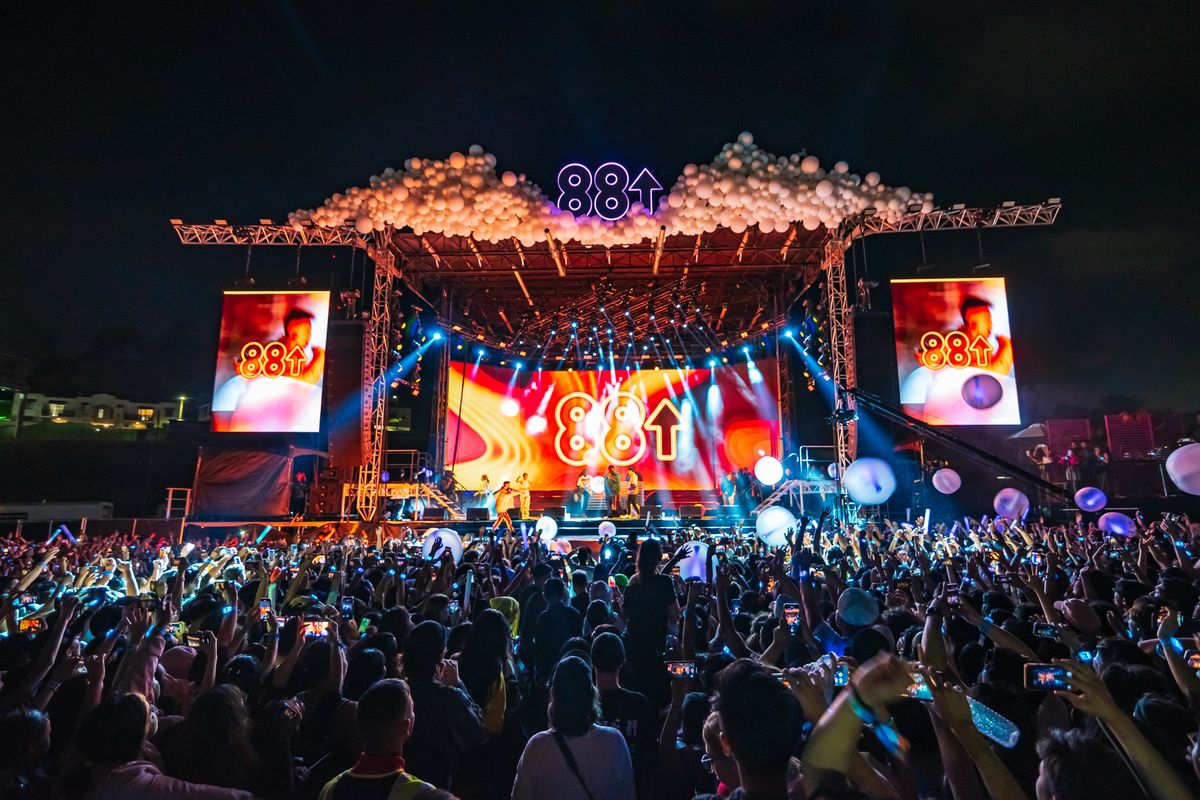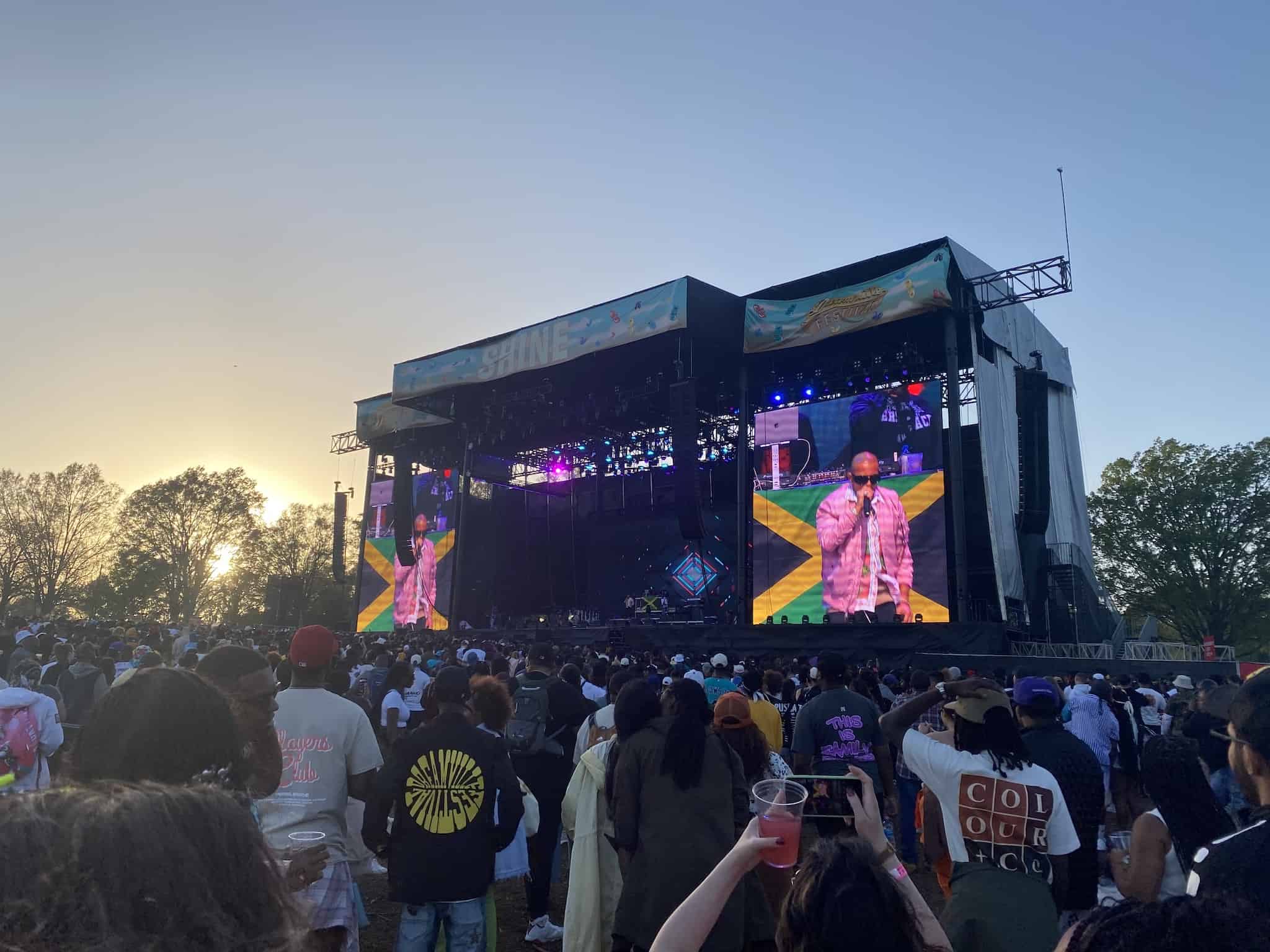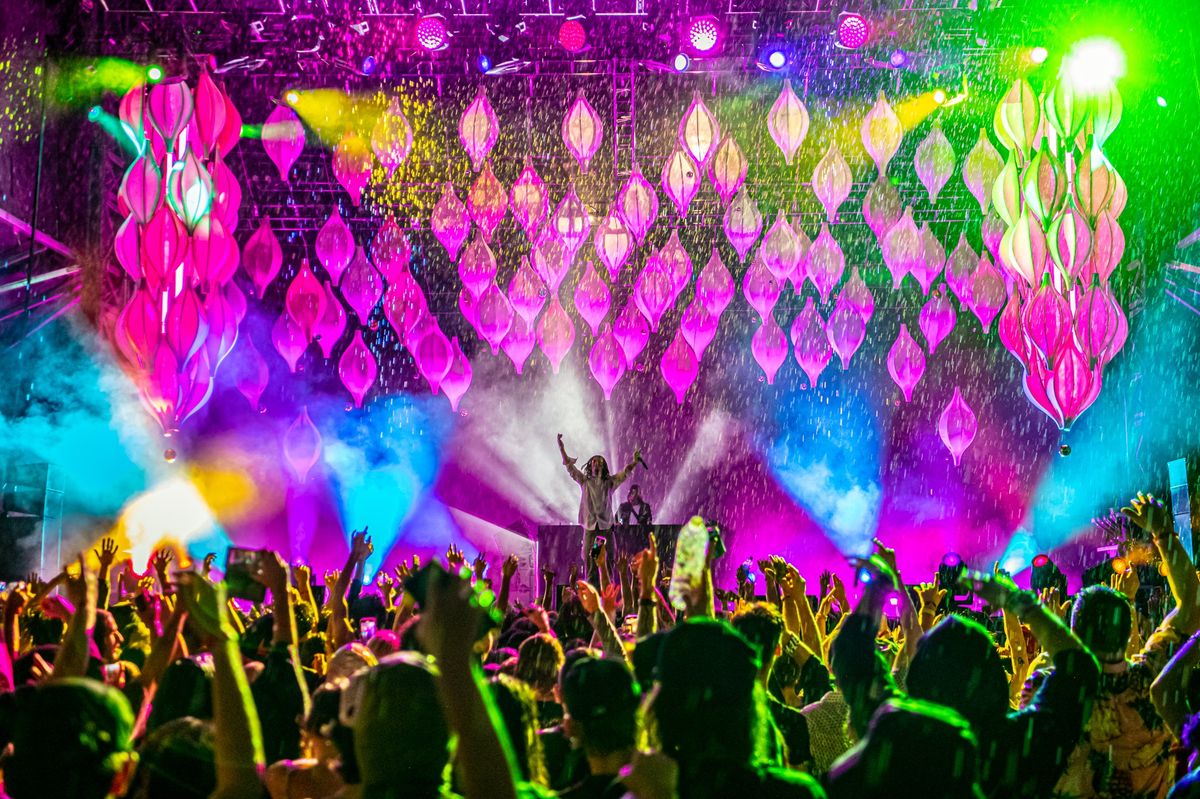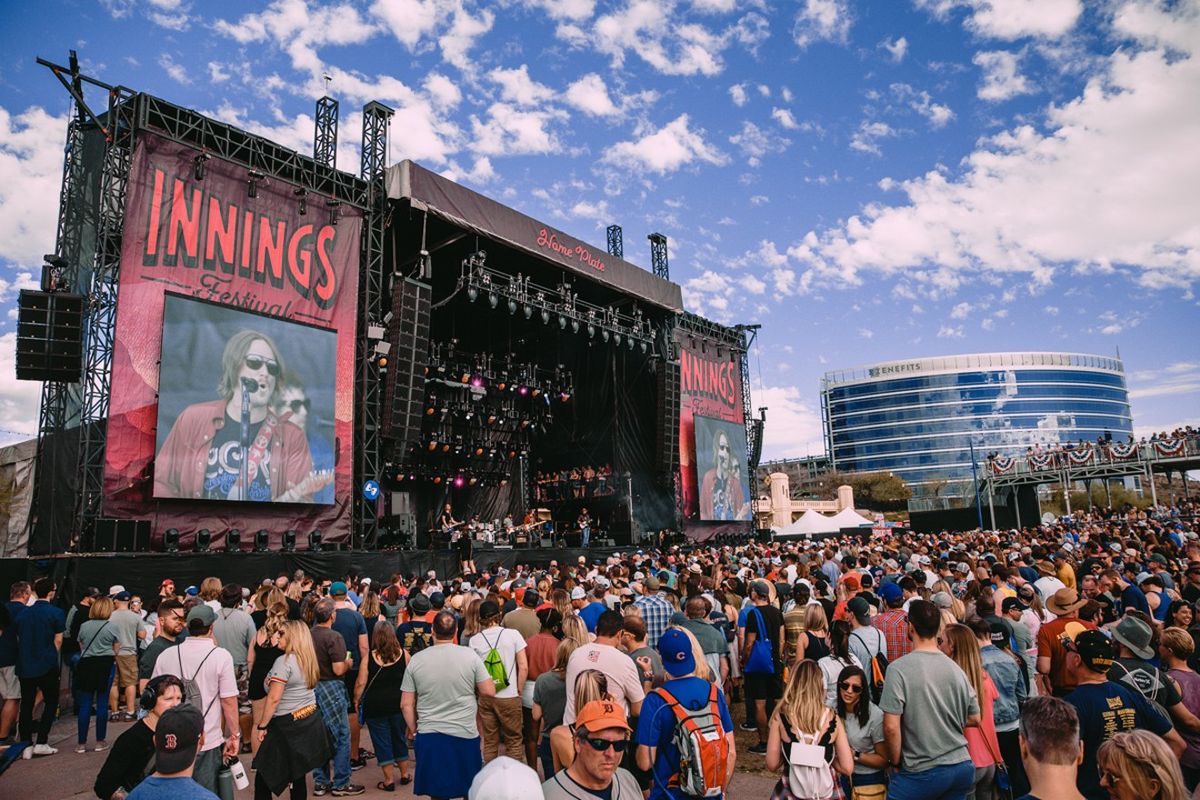Home>Events & Info>Festival>What Is Glastonbury Festival


Festival
What Is Glastonbury Festival
Modified: January 22, 2024
Discover the ultimate festival experience at Glastonbury Festival – immerse yourself in music, arts, and culture in the heart of the UK.
(Many of the links in this article redirect to a specific reviewed product. Your purchase of these products through affiliate links helps to generate commission for AudioLover.com, at no extra cost. Learn more)
Table of Contents
Introduction
Glastonbury Festival, widely regarded as one of the crown jewels of the festival circuit, is a colossal celebration of music, arts, and culture. Established in 1970, this iconic event takes place annually near the town of Pilton in Somerset, England. With its rich history, eclectic lineup, and captivating atmosphere, Glastonbury Festival has become a pilgrimage for music lovers from around the world.
What makes Glastonbury Festival unique is its diverse range of performances, spanning various genres and styles. From global superstars to emerging artists, the festival showcases an impressive array of talent. But Glastonbury is more than just a music festival; it also boasts an abundance of art installations, theater performances, circus acts, and much more.
The festival takes over a vast 900-acre site, with multiple stages and areas spread throughout the picturesque Worthy Farm. From the iconic Pyramid Stage to the intimate acoustic venues tucked away in the woods, there is a stage to suit every musical taste.
Glastonbury Festival isn’t just about entertainment; it is also committed to sustainability and eco-conscious practices. With initiatives such as banning single-use plastic bottles and encouraging recycling, the festival aims to minimize its environmental impact.
With its unique blend of music, arts, and community spirit, Glastonbury Festival provides an unforgettable experience for attendees. Whether you’re dancing in front of the main stage, exploring the vibrant market stalls, or simply soaking up the magical atmosphere, Glastonbury Festival is a once-in-a-lifetime event that leaves an indelible mark on those fortunate enough to be part of it.
History of Glastonbury Festival
The history of Glastonbury Festival dates back to 1970 when it was first organized by Michael Eavis on his dairy farm in Pilton, Somerset. Inspired by the Isle of Wight Festival, Eavis set out to create a music event with a more laid-back and inclusive atmosphere. The inaugural festival, known as the Glastonbury Fayre, attracted around 1,500 attendees and featured performances from acts such as Marc Bolan and Al Stewart.
Over the years, Glastonbury Festival has grown exponentially, becoming a significant cultural and musical landmark. The festival took a hiatus in the ’80s but returned in 1981 with an increased focus on diverse musical genres and a commitment to showcasing emerging talent alongside established artists.
One of the most iconic moments in Glastonbury’s history occurred in 1997 when Radiohead headlined the Pyramid Stage during a muddy downpour. The performance became legendary and helped solidify the festival’s reputation for unforgettable and transformative experiences.
Glastonbury Festival has also played host to some of the biggest names in the music industry. From David Bowie to Beyoncé, legends and megastars have graced the stages, creating historic moments and leaving audiences in awe.
In addition to music, Glastonbury Festival embraces a wide range of art forms. The festival features immersive art installations, interactive theater performances, and circus acts that enchant and captivate attendees. It has also become a platform for political and social activism, with various activists and organizations using the festival as a platform to raise awareness and inspire change.
Throughout its history, Glastonbury Festival has remained true to its roots of providing a platform for artists and fostering a sense of community. It has also evolved to reflect the changing times, incorporating new genres and artistic expressions, while staying true to its core values of inclusivity and creativity.
Today, Glastonbury Festival continues to be one of the most sought-after tickets in the music world, with thousands of people flocking to the fields of Worthy Farm every year for this unparalleled celebration of music, arts, and culture.
Location and Venue
Glastonbury Festival takes place in the enchanting countryside of Somerset, England. The festival is hosted on the sprawling grounds of Worthy Farm, which is located near the small village of Pilton. Surrounded by rolling green hills and picturesque landscapes, the location provides the perfect backdrop for this immersive experience.
Worthy Farm, owned by festival founder Michael Eavis, transforms into a vibrant and bustling temporary city during the festival. The site spans a staggering 900 acres, consisting of various fields and designated areas for different stages and attractions.
The centerpiece of Glastonbury Festival is the iconic Pyramid Stage, which stands majestically at the heart of the site. This main stage has hosted performances by some of the biggest names in music history and has become synonymous with the festival itself.
In addition to the Pyramid Stage, Glastonbury boasts numerous other stages, each with their own unique vibe and musical offerings. The Other Stage, The Park Stage, West Holts, and the Acoustic Stage are just a few of the many areas where festival-goers can discover diverse acts and genres.
Aside from the stages, the festival site is also home to various themed areas and zones. The Shangri-La district is renowned for its immersive art installations and late-night music parties, while the Green Fields area is dedicated to sustainability, well-being, and alternative cultures.
Getting to Glastonbury Festival is an adventure in itself. Located approximately 4 miles east of Glastonbury town, the festival site is easily accessible by car, train, or coach. The festival provides ample parking and operates shuttle buses from nearby transport hubs to facilitate smooth arrivals and departures.
Visitors are advised to plan their travel arrangements in advance, as the festival attracts a massive influx of people, and delays are common. However, the journey to Glastonbury is part of the experience, with excited festival-goers creating a vibrant atmosphere both on the road and on public transportation.
Overall, the location and venue of Glastonbury Festival contribute to its magical and immersive atmosphere. The scenic countryside setting, combined with the carefully curated stages and areas, creates a truly unique and unforgettable experience for all who attend.
Festival Dates
Glastonbury Festival traditionally takes place over four days, from Wednesday to Sunday, in the late month of June. However, the festival has occasionally included a Tuesday arrival day for certain ticket holders, allowing attendees to set up camp and get settled before the main festivities begin.
The exact dates of Glastonbury Festival can vary from year to year, as the organizers work closely with local authorities and take into consideration other major events and holidays that may impact attendance and logistics. It is advised to regularly check the official Glastonbury Festival website for the most up-to-date information regarding festival dates.
The festival kicks off with a grand opening ceremony, and music performances begin in the afternoon on Friday. Throughout the weekend, the festival offers continuous non-stop entertainment, with bands, solo artists, DJs, comedians, and other performers taking the stage at various times and locations.
On Sunday evening, Glastonbury Festival reaches its climax with a show-stopping headline performance on the Pyramid Stage. This highly anticipated closing act is often a crowning moment of the festival, leaving attendees with lasting memories and a sense of awe.
It’s important to note that Glastonbury Festival operates on a break year system, meaning that the festival takes a fallow year every few years to give the land and local infrastructure a chance to recover. During these fallow years, no festival takes place, allowing the organizers to plan and prepare for the next edition.
Attending Glastonbury Festival is more than just a music event; it’s an immersive experience where attendees can explore art installations, engage in workshops and discussions, indulge in delicious food and drinks from various vendors, and enjoy the vibrant and diverse atmosphere throughout the festival grounds.
Whether you choose to attend the full four days of the festival or arrive on a specific day, being part of Glastonbury Festival allows you to immerse yourself in an unforgettable celebration of music, arts, and culture.
Lineup and Performers
Glastonbury Festival is renowned for its impressive and diverse lineup, attracting some of the biggest names in the music industry alongside emerging and underground talent. The festival prides itself on offering a wide range of genres and styles, ensuring there is something for everyone’s musical taste.
The headliners of Glastonbury Festival are often the most anticipated and talked-about acts of the weekend. From rock legends to pop icons, these artists take the main stages and deliver electrifying performances that captivate the massive crowds. In recent years, the festival has seen the likes of The Rolling Stones, Adele, Beyoncé, and Radiohead grace the Pyramid Stage as headliners.
But Glastonbury is not just about the headliners; the lineup is packed with a plethora of talent across multiple stages and areas. The festival showcases a broad spectrum of musical genres, including rock, indie, electronic, hip-hop, folk, reggae, and more. From established acts to up-and-coming artists, Glastonbury Festival is a platform that celebrates creativity and pushes boundaries.
In addition to musical performances, Glastonbury Festival also features a lineup of comedians, spoken word artists, and theater acts. The festival’s comedy tent, known as ‘The Cabaret’, has hosted some of the best-known comedians in the world, providing laughter and light-hearted moments amidst the musical extravaganza.
One of the unique aspects of Glastonbury Festival is its dedication to showcasing artists from all corners of the globe. The festival celebrates diversity and fosters cultural exchange by featuring international acts that bring their unique sounds and rhythms to the stages. This global representation adds to the vibrant and inclusive atmosphere of the festival.
Glastonbury Festival also embraces collaboration and surprise performances. It’s not uncommon for artists to make unexpected appearances and join other acts on stage, creating unforgettable moments of musical magic.
As the festival approaches, the lineup is typically announced in the months leading up to the event. Attendees eagerly await this announcement, sparking excitement and speculation as to who will be gracing the stages that year.
Ultimately, the lineup and performers of Glastonbury Festival reflect the diversity, creativity, and musical excellence that the festival has come to represent. It’s a celebration of talent, a melting pot of genres, and an opportunity to discover new artists while enjoying the performances of established favorites.
Stages and Areas
Glastonbury Festival boasts a multitude of stages and areas, each offering a unique atmosphere and a platform for diverse performances. From the iconic Pyramid Stage to secret hidden venues, the festival provides a wealth of musical experiences for attendees to explore and enjoy.
The Pyramid Stage stands as the centerpiece of Glastonbury Festival, hosting the most anticipated performances of the weekend. This colossal open-air stage has witnessed legendary performances by artists such as David Bowie, Coldplay, and Beyoncé. The Pyramid Stage draws massive crowds who gather in front of its expansive field to sing, dance, and revel in the atmosphere.
The Other Stage, situated adjacent to the Pyramid Stage, offers a diverse array of musical genres, including rock, indie, and electronic music. Artists and bands from around the world showcase their talent on this platform, captivating audiences with their energetic and mesmerizing performances.
For those seeking a more intimate and acoustic setting, the Acoustic Stage provides a cozy and relaxed ambience. Nestled among the trees, this stage features stripped-down performances by renowned singer-songwriters who showcase their craft in an acoustic and intimate setting.
West Holts, formerly known as Jazz World, is a stage dedicated to celebrating contemporary and world music. From afrobeat to funk, soul to reggae, West Holts presents artists from diverse cultures and backgrounds, delivering pulsating and infectious rhythms that get festival-goers grooving.
The Park Stage is located on top of a hill, offering panoramic views of the festival site. This stage is known for its alternative and indie acts, drawing music enthusiasts who appreciate the quieter, more experimental, and boundary-pushing sounds of the festival.
Aside from the main stages, Glastonbury Festival features several themed areas and zones. The Shangri-La district is an immersive and visually stunning area where festival-goers can explore surreal art installations, street performances, and late-night parties. Block9 is another legendary area known for its futuristic and immersive clubbing experiences, with jaw-dropping stage designs and cutting-edge sounds.
The Green Fields area is dedicated to sustainability, well-being, and alternative lifestyles. It offers workshops, talks, and interactive exhibits focused on ecological and social issues. The Healing Fields provide a serene retreat where attendees can find relaxation, meditation, holistic therapies, and yoga sessions.
Whether you’re dancing in front of the main stages, venturing into hidden venues, or immersing yourself in artistic installations, Glastonbury Festival provides a vast array of stages and areas to explore. Each one offers its own unique vibe and musical offerings, ensuring that there’s something for every festival-goer to discover and enjoy.
Accommodation and Camping
Glastonbury Festival offers a range of options for accommodation and camping, providing attendees with the opportunity to immerse themselves fully in the festival experience.
The most popular accommodation choice is camping on-site. The festival provides designated camping areas where festival-goers can pitch their tents and create their own temporary homes for the duration of the event. There are different camping zones to suit different preferences, including family camping areas and quieter zones for those seeking a more relaxed atmosphere.
For those who prefer a little more comfort and convenience, there are also options for pre-pitched tents, luxury bell tents, and even stylish yurts available for hire. These options often come with additional amenities such as bedding, furnishings, and sometimes even electricity.
Another popular alternative to traditional camping is the Campervan and Caravan field. This area offers spaces for campervans, motorhomes, and caravans, providing festival-goers with the comfort of their own vehicles. However, spaces in the Campervan and Caravan field are limited and should be booked in advance.
Adjacent to the festival site, there is a dedicated area called Worthy View where pre-erected tents and wooden cabins are available for hire. This option provides a more comfortable and hassle-free camping experience, with amenities such as showers, toilets, and a secure area.
It’s important to note that Glastonbury Festival encourages sustainable camping practices. Participants are encouraged to pack lightly, bring reusable camping gear, and clean up after themselves. The festival aims to minimize waste and ensure the preservation of the beautiful countryside setting.
In addition to the camping options, there are also nearby off-site accommodations available for those who prefer a more traditional bed and a roof over their heads. Local bed and breakfasts, hotels, and holiday cottages offer various options for festival-goers who want to experience Glastonbury during the day and retreat to a comfortable space at night.
Regardless of the accommodation choice, it is essential to plan and book well in advance, as spaces for camping and off-site accommodations tend to fill up quickly. The Glastonbury Festival website provides information and resources to help attendees make the best decision for their accommodation needs.
No matter where festival-goers choose to rest their heads, the camping experience at Glastonbury Festival adds to the sense of community and adventure that defines this iconic event. Sharing meals, swapping stories, and making new friends in the campground is an integral part of the festival experience and contributes to the magical atmosphere that Glastonbury is known for.
Activities and Attractions
Glastonbury Festival is more than just a music event; it is a vibrant and immersive experience that offers a wide range of activities and attractions for attendees to enjoy. From art installations to circus acts, the festival provides a diverse program of entertainment both on and off the stages.
One of the highlights of Glastonbury Festival is the impressive display of art installations throughout the site. These captivating and often interactive artworks create a surreal and immersive environment for festival-goers to explore. From towering sculptures to intricately designed structures, the art installations add a sense of wonder and visual delight to the festival grounds.
Circus and street performances are also a popular attraction at Glastonbury. The festival hosts a range of talented performers, including acrobats, fire dancers, jugglers, and stilt walkers, who entertain and mesmerize the crowds. These captivating displays of skill and creativity can be found in designated circus tents and throughout the festival site.
The Kidz Field is a dedicated area for families and children, providing a wide range of engaging and entertaining activities. From workshops and crafts to storytelling and puppet shows, the Kidz Field offers a magical and dynamic space where children can unleash their creativity and have a memorable festival experience.
Theatre and spoken word performances are another prominent feature of Glastonbury Festival. The festival hosts a variety of theatrical productions, from Shakespearean performances to contemporary plays, providing a platform for talented actors and theater groups. Spoken word artists also take to the stages, captivating audiences with their powerful and thought-provoking performances.
In addition to the scheduled activities and performances, Glastonbury Festival offers a vibrant and diverse marketplace. The festival’s sprawling market area is filled with food stalls, vintage clothing shops, handmade crafts, and other unique vendors. Exploring the marketplace provides an opportunity to discover delicious international cuisines, purchase one-of-a-kind items, and interact with the passionate and creative individuals who make up the festival community.
For those looking to unwind and relax amidst the festival frenzy, Glastonbury Festival offers a variety of well-being and healing areas. These serene spaces provide a sanctuary for self-care, with offerings such as yoga classes, meditation sessions, massage treatments, and alternative therapies. Festival-goers can indulge in rejuvenating activities to restore balance and harmony during their time at the festival.
Whether through art installations, circus acts, theater performances, or the bustling marketplace, Glastonbury Festival provides a multitude of activities and attractions that engage and captivate attendees of all ages. The diverse program of entertainment ensures that there is always something new and exciting to discover, adding to the richness and depth of the festival experience.
Sustainable Initiatives
Glastonbury Festival has long been committed to sustainability and environmental stewardship, implementing various initiatives to reduce its carbon footprint and protect the beautiful countryside setting. The festival organizers recognize the importance of leading by example and have taken significant steps towards creating a more sustainable event.
One of the most notable sustainable initiatives at Glastonbury Festival is the ban on single-use plastic bottles. In an effort to reduce plastic waste, festival-goers are encouraged to bring their own refillable water bottles or purchase a stainless-steel Glastonbury Festival bottle on-site. Numerous water refill stations are available throughout the festival grounds, ensuring easy access to free, clean drinking water while minimizing the need for plastic bottle consumption.
Recycling and waste management are also prioritized at Glastonbury Festival. The festival provides recycling points in designated areas, making it easy for attendees to separate their waste and dispose of it responsibly. The festival’s waste management team works tirelessly to ensure that as much waste as possible is recycled or reused, diverting it from landfill.
Glastonbury Festival also encourages sustainable transportation methods. Festival-goers are urged to use public transportation or carpool with fellow attendees. The festival offers coordinated shuttle buses from nearby transport hubs to reduce the number of individual vehicles on the roads. Additionally, there are dedicated cycling routes and secure bike parking facilities to encourage eco-friendly travel options.
The festival takes steps to minimize its energy consumption as well. Glastonbury Festival encourages the use of renewable energy sources wherever possible, including solar panels and wind turbines to power various areas of the site. Energy-efficient lighting systems are used throughout the festival grounds to reduce electricity usage and minimize the festival’s carbon footprint.
Sustainable food options are also a focus at Glastonbury Festival. The festival strives to offer a variety of delicious and ethically sourced food choices. From organic and vegetarian options to locally sourced produce, the festival supports sustainable and responsible food practices. There is also a commitment to reducing food waste, with initiatives in place to donate surplus food to local charities after the event.
In addition to these initiatives, the festival actively supports local community projects and charities. Glastonbury Festival has a long-standing relationship with various grassroots initiatives, providing financial support and raising awareness for important causes. The festival encourages attendees to get involved and support these initiatives through donations, volunteer opportunities, and participation in charitable events.
By implementing these sustainable initiatives, Glastonbury Festival aims to not only reduce its environmental impact but also inspire and educate attendees about the importance of responsible and conscious living. The festival serves as a platform to showcase sustainable practices and encourages festival-goers to adopt these principles into their own lives beyond the event.
Ticket Information
Tickets for Glastonbury Festival are in incredibly high demand, often selling out within minutes of going on sale. It is advisable to be well-prepared and ready to purchase tickets as soon as they are released.
Before tickets go on sale, it is essential to register on the official Glastonbury Festival website. Registration is a straightforward process that involves providing personal details and uploading a photo. This registration is necessary to purchase tickets and helps prevent ticket touting and fraud.
There are different types of tickets available for Glastonbury Festival, including general admission tickets, coach package tickets, and separate tickets for campervans and caravans. General admission tickets are the most common and provide access to the festival site and camping areas. Coach package tickets include both festival admission and return coach travel from various locations across the UK.
When purchasing tickets, it is important to be aware of the terms and conditions set by the festival organizers. This includes restrictions on ticket resale, age restrictions for certain areas of the festival, and guidelines for permitted items and activities. It’s essential to read and understand these terms to ensure a smooth and enjoyable festival experience.
The pricing of Glastonbury Festival tickets varies from year to year and is announced prior to the ticket release date. Ticket prices typically include all entertainment, access to camping areas, and facilities within the festival site. Separate costs may apply for additional services such as pre-pitched tents, luxury camping options, or VIP packages.
In recent years, Glastonbury Festival has introduced a resale of returned tickets. These resale tickets give individuals who missed out on the initial ticket release another opportunity to secure a pass to the festival. Resale dates and details are typically announced after the initial ticket sale, allowing individuals to plan accordingly.
Glastonbury Festival also offers a limited number of free tickets for volunteers who sign up to work at the event. Volunteering can be a great way to experience the festival while contributing to its smooth running and vibrant atmosphere. Information on how to apply for volunteer positions can be found on the festival’s official website.
Given the high demand for tickets, it is important to be vigilant against ticket touts and unauthorized resale platforms. It is strongly advised to only purchase tickets through official channels to ensure validity and avoid potential scams.
Ultimately, securing a ticket to Glastonbury Festival is a sought-after opportunity to be part of a monumental celebration of music and arts. Being informed, registered, and prepared for ticket releases increases the chances of successfully obtaining entry to this iconic event.
Conclusion
Glastonbury Festival stands as an unparalleled celebration of music, arts, and community. From its humble beginnings in 1970 to its current status as one of the world’s most iconic festivals, Glastonbury has consistently delivered unforgettable experiences to attendees from all walks of life. The festival’s rich history, diverse lineup, and commitment to sustainability contribute to its enduring appeal.
Attending Glastonbury Festival is about more than just witnessing incredible performances; it is an immersive journey that transports you to a world of creativity, camaraderie, and self-discovery. From the moment you step onto the festival site, you are enveloped in a magical and vibrant atmosphere that captivates the senses.
Exploring the stages, discovering hidden art installations, and engaging with the myriad of activities and attractions, you become part of a diverse and inclusive community united by a shared love for music and arts. It is a place where lifelong friendships are forged, where strangers embrace as they sing along to their favorite songs, and where the indescribable feeling of being in the moment hits you with full force.
Glastonbury Festival is not just a temporary escape; it is a catalyst for change. Its commitment to sustainable initiatives, environmental responsibility, and social activism inspires reflection and sparks conversations about the interconnectedness of the world we inhabit.
However, the demand for tickets can be overwhelming, and securing entry requires planning and persistence. But for those who are fortunate enough to experience Glastonbury Festival, it is a transformative journey that leaves an indelible mark and creates memories that will last a lifetime.
As the sun sets over the fields of Worthy Farm, the collective energy of the crowd reaches a crescendo. The music fills the air, the lights illuminate the night sky, and a sense of belonging and pure joy envelops every soul in attendance. This is Glastonbury Festival, a celebration of music, arts, and the shared human experience.
So, whether you’re a seasoned festival-goer or embarking on your very first adventure, Glastonbury Festival promises an experience like no other. It is an invitation to immerse yourself in the beauty of music, discover new artists, connect with like-minded individuals, and create unforgettable memories in a setting that is as awe-inspiring as the performances themselves.











